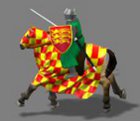| Fallen_KNiGHT_AC | Date: Sunday, 2011-09-11, 3:33 PM | Message # 1 |
 Colonel
Group: Administrators
Messages: 187
Status: Offline
| Who says history can’t be fun?!
Medievalists.net chats with Simon Bradbury about the medieval gaming world of Stronghold III
02 Sep Medievalists.net | September 2nd,2011 | Games, Interviews | Comments Off
Who says history can’t be fun?! Medievalists.net talks to Simon Bradbury about the medieval gaming world of Stronghold III

How did you get into video game creation?
My first game was a side scrolling arcade game called Elf – back in 1985 – in the days when the whole game could be made in 3 months by 2 people ! I have programmed and designed many genres of games but soon
settled on strategy games as the area the really grabbed me. In the 90s I worked as a freelance designer/coder on several strategy games such as the Caesar (think SimCity in Rome!), in 1999 I set up Firefly with Eric Ouellette and 2 ½ years later launched what is now our obsession, “Stronghold”.
Did you or other people at Firefly have a background or interest in medieval history? What drew you to create a medieval strategy game?
That’s a good question. We certainly wouldn’t have created seven medieval castle-building games if we didn’t already have an interest in the subject matter. Eric and I have always been fascinated by medieval history and my father dragged me around a fair few castles in my youth! (and maybe I’m turning into him as we regularly drag the team around medieval castle and sites as a kind of research exercise, always a load of fun , although that could just be the pub lunches !). We recently took on an intern partly because he had a History degree!
How do you go about doing your historical research for Stronghold?
Simulation and historical accuracy are pretty fundamental characteristics of Stronghold, not to mention highly valued by fans. Our London offices are littered with books on the crusades, life in the middle ages, siege warfare, feudalism etc, with similar reading material regularly sent over to our US office to help the artists out there. We reference a lot of these texts (in addition to our personal collection of castle photographs!) for character and building design.
Stronghold has also brought to life a number of real historical military skirmishes and castles. Then there’s the countless number of Stronghold fans, who endeavour with each new release to recreate the biggest and best medieval battles and castles. The accuracy is varied but the passion unquestionable!

You have now done several versions of the Stronghold series – how do you manage to keep the games fresh while retaining elements from previous games that your fans love?
Sequels are about experimenting with and refining the existing formula. The Stronghold franchise has been built around two core tenants, namely simulation and strategy. The first game was a comfortable balance of the two and was loved for it. With Stronghold 2 we decided to take the simulation aspect further, adding judicial
systems and other features to better simulate medieval life. After working on several different versions of Stronghold we know what works and only the best features are making the cut for Stronghold 3. We’ve listened to the fans and made sure the things they loved about previous games in the series are refined and included, in addition to a host of new features like physics-based traps to keep things fresh.

You also are starting Stronghold Kingdoms, an online version of the game – what challenges do you have in designing this game compared to your traditional versions?

The main design challenge with Stronghold Kingdoms, (as with any MMO I guess) we found to be the extremely long time it takes to balance the game. We are used to PC games that take maybe 30mins to an hour to play though, after which we can adjust parameters, change levels, introduce new elements etc. That time frame means that we can easily iterate through a level in a few days. However with an MMO time is stretched out as the game need to play over days, weeks, months and even years for longer term players. So the play and rebalance cycle is rather longer as !!! So a of the rebalancing is much, much slower and involves more guess work – it also means that rebalancing continues on though out the active lifespan of the game.

Another challenge is obviously the tech, as it’s a huge change from a discrete PC program to a distributed game that lives oncloud severs and SQL databases and the problems that presents, sometime s you just can’t do exactly what you want as a designer as it would create too high a bandwidth loading or the game servers would slow down to the point that they would lag
if 1000’s of players are trying to utilise the same piece of complicated code on a remote server. The design compromises and hurdles have been a long (3 year) learning curve for us, as we have adjusted for change in distribution technology.

Other challenges for us as a company have been maintenance and building a bigger support team along with volunteer members of the community, (‘Mods’), to keep an eye on the game world, and deal with technical issues. Cheating also is a bigger issue, if a player cheats in a single-player game the only person they affect is themselves, they only change their own solitary experience of the game. When you’re playing with hundreds of thousands of other people and you decide to cheat, you’re putting every legitimate player at a disadvantage, reducing the significance of progress they worked hard
to achieve.
There are many other challenges believe me, but we now finally feel we are on top of them and look forward to developing Stronghold kingdoms further and indeed producing other online titles…
Source: http://www.medievalists.net/2011....old-iii
|
| |
| |





